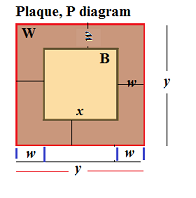dave13 wrote:
Erjan_S wrote:
Bunuel wrote:
No I mean ANY width is possible.
Let the the side of small square be \(x\) and the big square \(y\).
Given: \(\frac{x^2}{y^2-x^2}=\frac{25}{39}\) --> \(\frac{x^2}{y^2}=\frac{25}{64}\) --> \(\frac{x}{y}=\frac{5}{8}\).
We are asked which value of \(\frac{y-x}{2}\) is possible. \(\frac{y-\frac{5}{8}y}{2}=\frac{3}{16}y=?\).
Well, expression \(\frac{3}{16}y\) can take ANY value depending on \(y\): 1, 3, 4, 444, 67556, 0,9, ... ANY. Basically we are given the ratios of the sides (5/8), half of their difference can be any value we choose, there won't be any "impossible" values at all.
Hope it's clear.
I have difficulties this part \(\frac{x^2}{y^2-x^2}=\frac{25}{39}\) --> \(\frac{x^2}{y^2}=\frac{25}{64}\)
How do you get it?
hello
generis 
i am honored to tag you and ask you three questions
 Q # 1:
Q # 1: SEE BELOW
Q # 2: SEE BELOW
Q # 3: SEE BELOW
Many thanks and have an awesome weekend !
 P.S.
P.S.  by the way in your signature isnt there a SC issue ?
by the way in your signature isnt there a SC issue ? 
it says "In the depths of winter, I finally learned
that within me there lay an invincible summer."
but shouldnt we say so "In the depths of winter, I finally learned
that within me there is a thick layer of an invincible hot summer mood " 



OMG you are irrepressible.
Hi
dave13 -
Your second question is hard to answer.
I cannot tell whether you are following the algebra.
Others have had a hard time. Maybe this write-up will help.
I am assigning capital letter variables in order to write as abbreviated an
answer as possible.
Let
P =
the whole PLAQUE (which is a "big square").
Area of
\(P = y^2\)Let
B = the
square BRASS inlay (which is a "little square). Area of
\(B = x^2\)Let
W = the
WOODEN part (which is a uniform strip,
like a "frame"). Area of
\(W = y^2-x^2\)Quote:
Q # 1: i reviewed whole thread and all explanations but cant understand why do we divide by 2 here \(\frac{y-x}{2}\)?
Short answer: because there are TWO border widths between \(y\) and \(x\). TAKE A LOOK:
Attachment:
 woodenborder.png [ 8.24 KiB | Viewed 7337 times ]
woodenborder.png [ 8.24 KiB | Viewed 7337 times ]
We are solving for the width of the border.
Does (side y) - (side x) = width of border?
No.
\((y - x)\) = TWO times the width of the border
Why? On EACH side of \(x\), there is one border width, \(w\):
\(y = w + x + w\)
\(y - x = 2w\)
\(w = \frac{y-x}{2}\)Try drawing the diagram. Let's say \(x = 2, y = 4\), and width of wooden frame, W = 1 (write values in)
Does
\((y - x)\) = width of wooden border?
\((y-x) = 2. W = 1\). Not correct.
\((y - x) = 2\) * width of the wooden border.
Width of border therefore equals
\(\frac{y-x}{2}=\frac{4-2}{2}=1\)Quote:
Q # 2: why do we subtract \(x^2\)from \(y^2\) here in the denominator \(\frac{x^2}{y^2-x^2}\) ? we know that ratio is \(\frac{25}{39}\), why to subtract ?

Short answer: We subtract because
1)
\(y^2 - x^2\) equals the area of the wooden part, which
2) is the bottom part of the ratio given by the prompt
(I think you may be slightly confused about area of "the wooden part." It's the frame, the thin strip.)
We need this ratio:
\(\frac{Area_{B}}{Area_{W}}\), in which
\(Area_{W} = y^2-x^2\),
to get another ratio: side length of B to side length of P.
\(\frac{InnerSquareArea}{WoodenFrameArea} = \frac{25}{39}\)1) inner square area of P =
\(x^2\)2) wooden frame area =
\((y^2 - x^2)\)Think of the area of the wooden frame as a "shaded region."
You would find the shaded region's area by subtracting B's area
\((x^2)\) from P's area
\((y^2)\).
We go from
\(\frac{area of B}{area of W}\) to \(\frac{Side of B(=x)}{Side of P(=y)}\) to
border width= some y expressionBorder width depends on length of \(y\). That demonstration has steps
1) Use the given ratio of \(\frac{Barea}{Warea}\) to find ratio between the areas of the squares The
given ratio is NOT between the areas of the two squares (that's what we need to find)
GIVEN ratio is
\(\frac{B}{W} = \frac{25}{39}\)Area of W = (Area of P - Area of B) (think of W as a shaded region)
Area of P =
\(y^2\)Area of B =
\(x^2\)Area of W =
\(y^2 - x^2\)Substitute that RHS for W in the original ratio.
\(\frac{B}{W}=\frac{x^2}{y^2-x^2}=\frac{25}{39}\)
To find the ratio of areas of squares (P and B), we need
\(x^2\) over
\(y^2\)Eliminate \(x^2\) in the denominator.
Cross multiply:
\(\frac{x^2}{y^2-x^2}=\frac{25}{39}\)
\(39x^2 = 25y^2 - 25x^2\)
\(64x^2=25y^2\) DIVIDE both sides by
\(y^2\) and by
\(64\)\(\frac{x^2}{y^2}=\frac{25}{64}\)(2) Use areas of squares to find ratio of side lengths of squaresFind ratio of side x to side y by taking the square root of
\(\frac{x^2}{y^2}=\frac{25}{64}\):
\(\frac{x}{y}=\frac{5}{8}\)
(3) Express width of the border in terms of \(y\) only At #2 we still have a ratio. Still no counting number.
Width of the border depends on \(y.\)
But \(y\) can be any length. NO limit on values for y = no limit on border width
Bunuel 's next steps simply detail THAT there are no limits on the longer side.
He shows that
every answer depends on \(y\)
Defining border width in terms of \(y\)Recall that border width = \(\frac{y-x}{2}\)
Define everything in terms of \(y\). Use the side ratio to do so
\(\frac{x}{y}=\frac{5}{8}\)
Multiply both sides by \(y\)
\(x = \frac{5}{8}y\)Substitute that RHS for \(x\)
Border width calculation:
\(\frac{y - x}{2} =\frac{y -\frac{5}{8}y}{2}\)\(\frac{y-\frac{5}{8}y}{2}=(\frac{\frac{8}{8}y-\frac{5}{8}y}{2})=(\frac{\frac{3}{8}y}{2})\)
\(\frac{\frac{3}{8}y}{2}=(\frac{3}{8}y*\frac{1}{2})=\frac{3}{16}y\)
Border width equals \(\frac{3}{16}\) of \(y\)
That's nice, but
how long can \(y\) be? \(y\)'s length can be ANY real number.
The width of the border, dependent on \(y\)'s length,
can be ANY value that is \(\frac{3}{16}\) of an infinite set of possibilities.
Quote:
Q # 3: my approach to to tho problem was simple i rounded 39 to 40 so i simply got ratio \(\frac{25}{40} = \frac{5}{8}\) do you think its correct approach ?


Excellent idea to try to find shortcuts.

But . . . wrong ratio. You got lucky.
To find side length, given area of squares, you must take a square root. AND you must be solving for the right parts.
\(\frac{25}{39}\) is the ratio of \(\frac{AreaB}{AreaW}\)
\(\frac{5}{8}\) is ratio of \(\frac{SideB}{SideP}\)
Your progression seems to be:
\(\frac{25}{39}= \frac{AreaB}{AreaP}=\frac{SideB}{SideW}\)The ratio you derived is not correct:
\(P\neq{W}\)Tip: be clear about the
parts of the ratios you set up. WHICH side to WHICH side, e.g.
I hope that helps.

(whew!)
You get kudos for making me laugh about the SC issues in my signature. I am a reading fool (fanatic). Elegant prose uses metaphor. SC questions are hard but . . . most do not display elegant prose. BTW, the author was an astonishing human being. But did you REALLY go after my pick for translation of “Au milieu de l'hiver, j'apprenais enfin qu'il y avait en moi un été invincible”? Thou art brave. 













